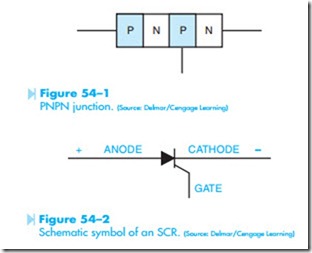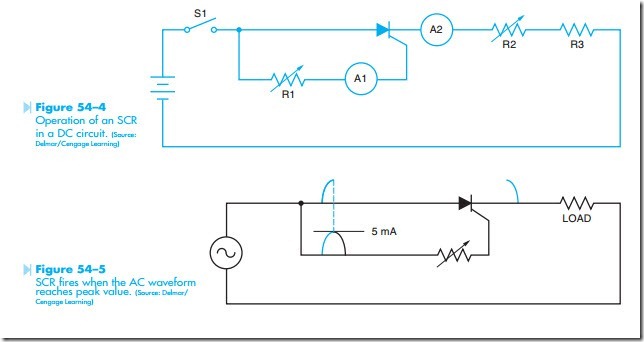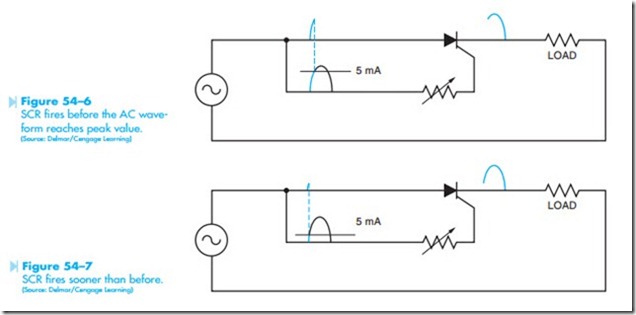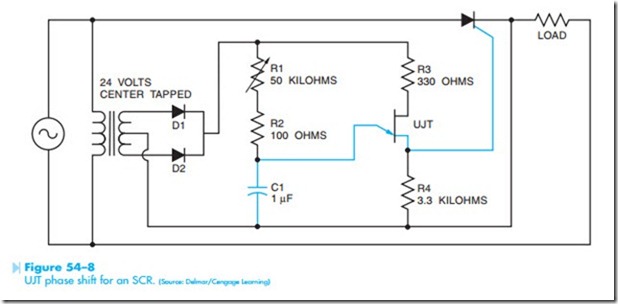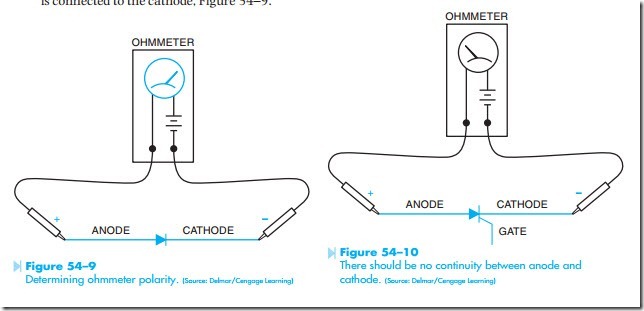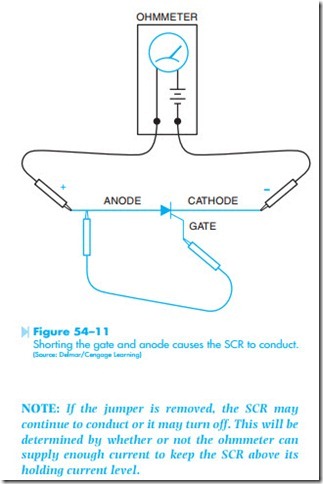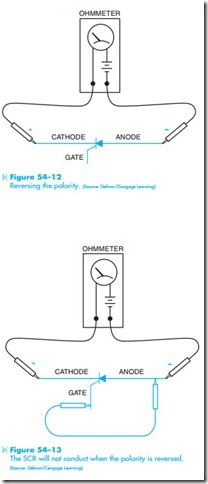The Silicon- Controlled Rectifier
The silicon-controlled rectifier (SCR) is often referred to as the PNPN junction because it is made by joining four layers of semiconductor material together, Figure 54–1. The schematic symbol for the SCR is shown in Figure 54–2. Notice that the symbol for the SCR is the same as the diode except that a gate lead has been added.
SCR CHARACTERISTICS
The SCR is a member of a family of devices known as thyristors. Thyristors are digital devices in that they have only two states, on or off. The SCR is used when it is necessary for an electronic device to control a large amount of power. Assume an SCR has been connected in a circuit as shown in Figure 54–3. When the SCR is turned off, it will drop the full voltage of the circuit and 200 volts will
appear across the anode and cathode. Although the SCR has a voltage drop of 200 volts, there is no current flow in the circuit. The SCR does not have to dissipate any power in this condition (200 volts X 0 amps = 0 watts). When the push button is pressed, the SCR will turn on. When the SCR turns on, it will have a voltage drop across its anode and cathode of about 1 volt. The load resistor limits the circuit current to 2 amps (200 volts/100 ohms = 2 amps). Because the SCR now has a voltage drop of 1 volt and 2 amps of current is flowing through it, it must now dissipate 2 watts of heat (1 volt X 2 amps = 2 watts). Notice that the SCR is dissipating only 2 watts of power, but is controlling 200 watts.
THE SCR IN A DC CIRCUIT
When an SCR is connected in a DC circuit as shown in Figure 54–3, the gate will turn the SCR on but will not turn the SCR off. The gate must be to turn the anode-cathode section of the SCR on. Once the gate has turned the SCR on, it will remain turned on until the current flowing through the anode-cathode drops to a low enough level to per- mit the device to turn off. The amount of current required to keep the SCR turned on is called the holding current, Figure 54–4. Assume resistor R1 has been adjusted for its highest value and resistor R2 has been adjusted to its lowest or 0 value. When switch S1 is closed, no current will flow through the anode-cathode section of the SCR because resistor R1 prevents enough current flowing through the gate-cathode section of the SCR to trigger the device. If resistor R1 is slowly decreased in value, current flow through the gate- cathode will slowly increase. When the gate cur- rent reaches a certain level, assume 5 mA for this SCR, the SCR will fire or turn on. When the SCR fires, current will flow through the anode-cathode section and the voltage drop across the device becomes about 1 volt. Once the SCR has turned on, the gate has no more control over the device and could be disconnected from the anode without having any effect on the circuit. When the SCR fires, the anode-cathode becomes a short circuit for all practical purposes and current flow is limited by resistor R3. Now assume that resistor R2 is slowly increased in value. When the resistance of R2 is slowly increased, the current flow through the anode-cathode will slowly decrease. Assume that when the current flow through the anode-cathode drops to 100 mA, the device suddenly turns off and the current flow drops to 0. This SCR requires 5 mA of gate current to turn it on, and has a hold- ing current value of 100 mA.
THE SCR IN AN AC CIRCUIT
The SCR is a rectifier. When it is connected in an AC circuit the output will be DC. The SCR operates in the same manner in an AC circuit as it does in a DC circuit. The difference in operation is caused by the AC waveform falling back to 0 at the end of each half cycle. When the AC waveform drops to 0 at the end of each half cycle, it will permit the SCR to turn off. This means the gate must re-trigger the SCR for each cycle it is to conduct. Refer to the circuit shown in Figure 54–5.
Assume that the variable resistor connected to the gate has been adjusted to permit 5 mA of cur- rent to flow when the voltage applied to the anode reaches its peak value. When the SCR turns on, current will begin flowing through the load resis- tor when the AC waveform is at its positive peak. Current will continue to flow through the load until the decreasing voltage of the sine wave causes the current to drop below the holding current level of 100 mA. When the current through the anode- cathode drops below 100 mA, the SCR turns off and all current flow stops. The SCR will remain turned off when the AC waveform goes into the negative half cycle because it is reverse biased and cannot be fired.
If the resistance connected in series with the gate is reduced, a current of 5 mA will be reached before the AC waveform reaches it peak value, Figure 54–6. This causes the SCR to fire sooner in the cycle. Since the SCR fires sooner, current is per- mitted to flow through the load resistor for a longer period of time, which causes a higher average volt- age drop across the load. If the resistance of the gate circuit is reduced again, as shown in Figure 54–7, the 5 mA of gate current needed to fire the SCR will be reached sooner than before. This permits cur- rent to begin flowing through the load sooner than before, which permits a higher average voltage to be dropped across the load.
Notice that this circuit will permit the SCR to control only half of the positive waveform. The latest the SCR can be fired in the cycle is when the AC wave- form is at 90° or peak. If a lamp were used as the load for this circuit, it would burn at half brightness when the SCR first turned on. This control would permit the lamp to be operated from half brightness to full brightness, but it could not be operated at a level less than half brightness.
PHASE SHIFTING THE SCR
If the SCR is to control all of the positive waveform, it must be phase shifted. As the term implies, phase shifting means to shift the phase of one thing in reference to another. In this instance, the volt- age applied to the gate must be shifted out of phase with the voltage applied to the anode. There are several methods that can be used for phase shifting an SCR, but it is beyond the scope of this text to cover all of them. The basic principles are the same for all of the methods, however, so only one method will be covered.
If the SCR is to be phase shifted, the gate circuit must be unlocked or separated from the anode circuit. The circuit shown in Figure 54–8 will accomplish this. A 24-volt center-tapped transformer has been used to isolate the gate circuit from the anode circuit. Diodes D1 and D2 are used to form a two- diode type of full wave rectifier to operate the unijunction transistor (UJT) circuit. Resistor R1 is used to determine the pulse rate of the UJT by controlling the charge time of capacitor C1. Resistor R2 is used to limit the current through the emitter of the UJT if resistor R1 is adjusted to 0 ohms. Resistor R3 limits current through the base 1–base 2 section when the UJT turns on. Resistor R4 permits a voltage spike or pulse to be produced across it when the UJT turns on and discharges capacitor C1. The pulse produced by the discharge of capacitor C1 is used to trigger the gate of the SCR.
Because the pulse of the UJT is used to provide a trigger for the gate of the SCR, the SCR can now be fired at any time regardless of the voltage applied to the anode. This means the SCR can now be fired as early or late during the positive half cycle as desired, because the gate pulse is now determined by the charge rate of capacitor C1. The voltage across the load can now be adjusted from 0 to the full applied voltage.
TESTING THE SCR
The SCR can be tested with an ohmmeter. To test the SCR, connect the positive output lead of the ohmmeter to the anode and the negative lead to the cathode. The ohmmeter should indicate no continuity. Touch the gate of the SCR to the anode. The ohmmeter should indicate continuity through the SCR. When the gate lead is removed from the anode, conduction may stop or continue, depending on whether the ohmmeter is supplying enough current to keep the device above its holding current level or not. If the ohmmeter indicates continuity through the SCR before the gate is touched to the anode, the SCR is shorted. If the ohmmeter will not
indicate continuity through the SCR after the gate has been touched to the anode, the SCR is open. The following step-by-step procedure can be used for testing an SCR.
1. Using a junction diode, determine which ohmmeter lead is positive and which is negative. The ohmmeter will indicate continuity only when the positive lead is connected to the anode of the diode and the negative lead is connected to the cathode, Figure 54–9.
2. Connect the positive ohmmeter lead to the anode of the SCR and the negative lead to the cathode. The ohmmeter should indicate no continuity, Figure 54–10.
3. Using a jumper lead, connect the gate of the SCR to the anode. The ohmmeter should indicate a forward diode junction when the connection is made, Figure 54–11.
4. Reconnect the SCR so that the cathode is connected to the positive ohmmeter lead and the anode is connected to the negative lead. The ohmmeter should indicate no continuity, Figure 54–13
5. If a jumper lead is used to connect the gate to the anode, the ohmmeter should indicate no continuity, Figure 54–13. SCRs in different case styles are shown in Figure 54–14.
NOTE: SCRs designed to switch large current (50 amperes or more) may indicate some leakage
